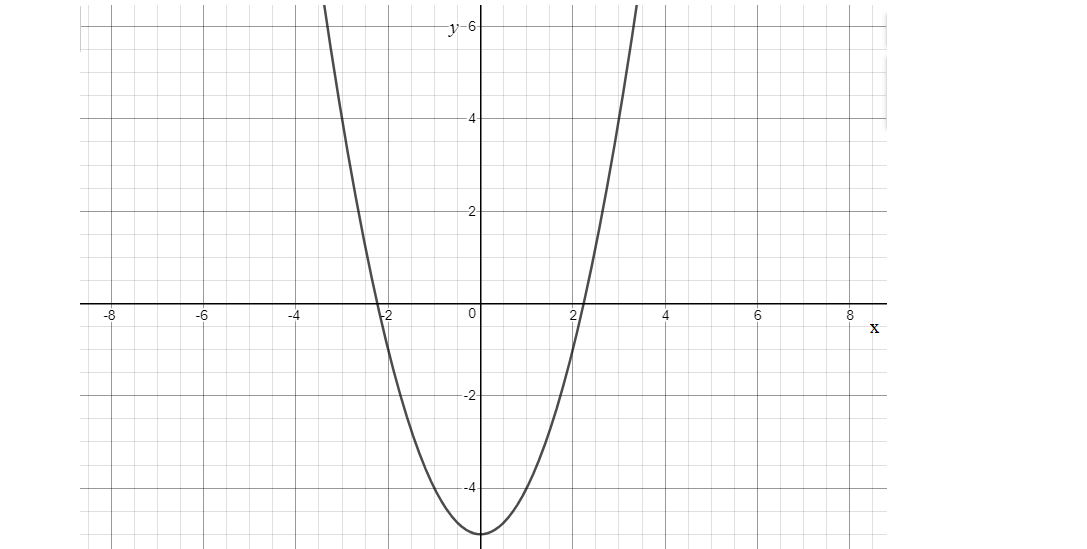Answer
382.2k+ views
Hint: The basic equation of parabola is \[y = a{x^2} + c\], in which the vertical movement along a parabola’s line of symmetry is called a vertical shift. A vertical shift is when the graph literally moves vertically, up or down. As the given equation is a quadratic equation, the graph of a quadratic function is represented using a parabola. Vertex of a quadratic equation is its minimum or lowest point if the parabola is opening upwards or its highest or maximum point if it opens downwards.
Complete step by step solution:
Given,
\[y = {x^2} - 5\]
If you know the graph of a function \[y = f\left( x \right)\], then you can have four kind of transformations: the most general expression is:
\[Af\left( {wx + h} \right) + v\]
Where:
\[ \to \]\[A\]multiplies the whole function, thus stretching it vertically (expansion if \[\left| A \right| > 1\], contraction otherwise)
\[ \to \]\[w\]multiplies the input variable, thus stretching it horizontally (expansion if \[\left| w \right| > 1\], contraction otherwise)
\[ \to \]h and v are, respectively, horizontal and vertical translations.
In this given function, starting from \[f\left( x \right) = {x^2}\], you have \[A = 1\]and \[w = 1\]. Being multiplicative factors, they have non-effect.
Moreover, \[h = 0\]. Being ad additive factor, it has non-effect.
Finally, you have \[v = - 5\]. This means that, if you start from the "standard" parabola \[f\left( x \right) = {x^2}\], to describe the transformation going on the graph of \[f\left( x \right) = {x^2} - 5\] is the same, just translated 5 units down.
The graph is shown as:

Note: We know that the basic equation of parabola is \[y = a{x^2} + c\], here given function we have a=1, if a is positive the parabola opens upwards as a is greater than 1, the parabola is narrow about its line of symmetry. The movement is all based on the y-value of the graph. The y-axis of a coordinate plane is the vertical axis. When a function shifts vertically, the y-value changes. Adding or subtracting a positive constant k to \[f\left( x \right)\] is called a vertical shift. Adding or subtracting a positive constant h to x is called a horizontal shift.
Complete step by step solution:
Given,
\[y = {x^2} - 5\]
If you know the graph of a function \[y = f\left( x \right)\], then you can have four kind of transformations: the most general expression is:
\[Af\left( {wx + h} \right) + v\]
Where:
\[ \to \]\[A\]multiplies the whole function, thus stretching it vertically (expansion if \[\left| A \right| > 1\], contraction otherwise)
\[ \to \]\[w\]multiplies the input variable, thus stretching it horizontally (expansion if \[\left| w \right| > 1\], contraction otherwise)
\[ \to \]h and v are, respectively, horizontal and vertical translations.
In this given function, starting from \[f\left( x \right) = {x^2}\], you have \[A = 1\]and \[w = 1\]. Being multiplicative factors, they have non-effect.
Moreover, \[h = 0\]. Being ad additive factor, it has non-effect.
Finally, you have \[v = - 5\]. This means that, if you start from the "standard" parabola \[f\left( x \right) = {x^2}\], to describe the transformation going on the graph of \[f\left( x \right) = {x^2} - 5\] is the same, just translated 5 units down.
The graph is shown as:

Note: We know that the basic equation of parabola is \[y = a{x^2} + c\], here given function we have a=1, if a is positive the parabola opens upwards as a is greater than 1, the parabola is narrow about its line of symmetry. The movement is all based on the y-value of the graph. The y-axis of a coordinate plane is the vertical axis. When a function shifts vertically, the y-value changes. Adding or subtracting a positive constant k to \[f\left( x \right)\] is called a vertical shift. Adding or subtracting a positive constant h to x is called a horizontal shift.
Recently Updated Pages
When people say No pun intended what does that mea class 8 english CBSE

Name the states which share their boundary with Indias class 9 social science CBSE

Give an account of the Northern Plains of India class 9 social science CBSE

Change the following sentences into negative and interrogative class 10 english CBSE

Advantages and disadvantages of science

10 examples of friction in our daily life

Trending doubts
Difference between Prokaryotic cell and Eukaryotic class 11 biology CBSE

Which are the Top 10 Largest Countries of the World?

Fill the blanks with the suitable prepositions 1 The class 9 english CBSE

Differentiate between homogeneous and heterogeneous class 12 chemistry CBSE

Difference Between Plant Cell and Animal Cell

10 examples of evaporation in daily life with explanations

Give 10 examples for herbs , shrubs , climbers , creepers

Write a letter to the principal requesting him to grant class 10 english CBSE

How do you graph the function fx 4x class 9 maths CBSE



